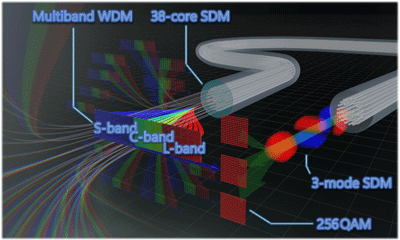Scientists from the National Institute of Information and Communications Technology (NICT, President: Hideyuki Tokuda, Ph.D.), collaborated with the Eindhoven University of Technology and the University of L'Aquila and achieved a groundbreaking data rate of 22.9 petabits per second using a solitary optical fiber.
 Conceptual image of the ultralarge-capacity optical fiber transmission in this study. Image Credit: National Institute of Information and Communications Technology (NICT).
Conceptual image of the ultralarge-capacity optical fiber transmission in this study. Image Credit: National Institute of Information and Communications Technology (NICT).
This accomplishment more than doubled their world record of 10.66 petabits per second.
The research successfully integrated cutting-edge technologies like large-scale Space Division Multiplexing (SDM) and multi-band Wavelength Division Multiplexing (WDM), showcasing a viable path toward future ultra-large capacity optical communication networks.
The noteworthy results of this experiment were acknowledged with a post-deadline paper presentation at the 49th European Conference on Optical Communications (ECOC 2023), delivered by Ben Puttnam on Thursday, October 5th, 2023.
Background
In response to the escalating demands for data traffic, researchers have explored multiplexing technologies utilizing space and wavelength for high data-rate optical fiber communications.
The former employs advanced optical fibers incorporating multiple optical paths (channels) within a common cladding. Meanwhile, the latter augments the overall transmission capacity by expanding the transmission bandwidth to accommodate numerous independent Wavelength Division Multiplexed (WDM) data channels.
As of now, NICT has achieved Space Division Multiplexing (SDM) with over 100 spatial channels, which is achieved by combining multicore fiber (MCF) and multimode fiber transmission technologies. Additionally, they have implemented multi-band WDM with a total bandwidth of 20 THz, utilizing the S-, C-, and L-bands.
However, the combined application of multi-band WDM and SDM has been demonstrated only for uncoupled four-core MCFs in cases of very short distances (1 km).
To integrate multi-band WDM and SDM with fibers featuring a large spatial channel count (for example, 114 channels with a 38-core 3-mode fiber), a multi-band-compatible MIMO receiver becomes imperative.
Achievements
NICT showcased the feasibility of fiber-optic data communication at an impressive rate of 22.9 petabits per second, surpassing the previous record of 10.66 petabits per second by more than double. This achievement was made possible through the inaugural integration of multi-band WDM and multi-core, multi-mode SDM, facilitated by a multi-band-compatible MIMO receiver.
293 wavelength channels operated within the S-band, while 457 were utilized in the C- and L-bands, resulting in a sum of 750 WDM channels. These collectively covered a frequency bandwidth spanning 18.8 THz.
Signal modulation employed polarization-multiplexed 256 QAM. The multi-band WDM transmission demonstration showcased a remarkable increase of 28.5 times in the number of spatial channels.
The measured transmission capacity for each core ranged from approximately 0.3 to 0.7 petabits per second, contributing to an overall transmission capacity of 22.9 petabits per second.
The achieved data rate incorporates an overhead for an implemented forward-error correction code, and the demonstration indicated the potential for up to 24.7 Pb/s with better-optimized coding. This surpasses the data rate of currently deployed optical fiber communication systems by over 1,000 times.
While uncoupled four-core MCF proves suitable for initial implementation, future advancements in the telecommunication infrastructure will necessitate further enhancements using ultra-large-capacity optical fibers.
Anticipating a three-order-of-magnitude increase in data traffic demand, this study marks the first successful combination of multi-band WDM and SDM using a multicore multimode fiber—a crucial step toward realizing future ultra-large-capacity optical fiber communication networks.
Future Prospects
NICT is committed to further investigating multi-band WDM across extensive SDM fibers, encompassing randomly coupled MCFs or multimode fibers, necessitating substantial multi-band MIMO receivers.
The outcomes of this experiment have been acknowledged through acceptance as a post-deadline paper presentation at the 49th European Conference on Optical Communications (ECOC 2023, held in Glasgow, UK, from October 1st to 5th, 2023) and were presented on Thursday, October 5th, 2023.